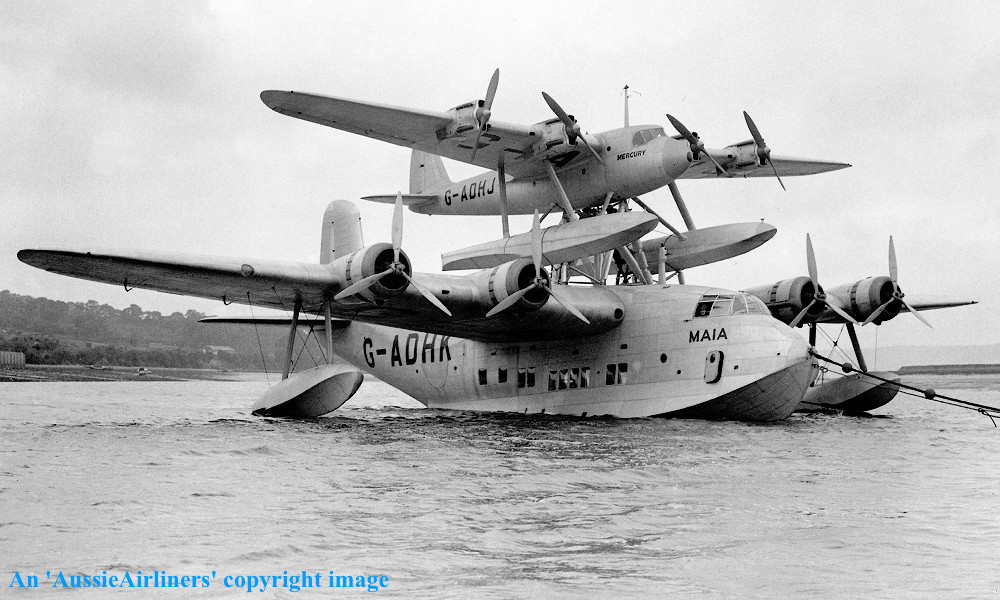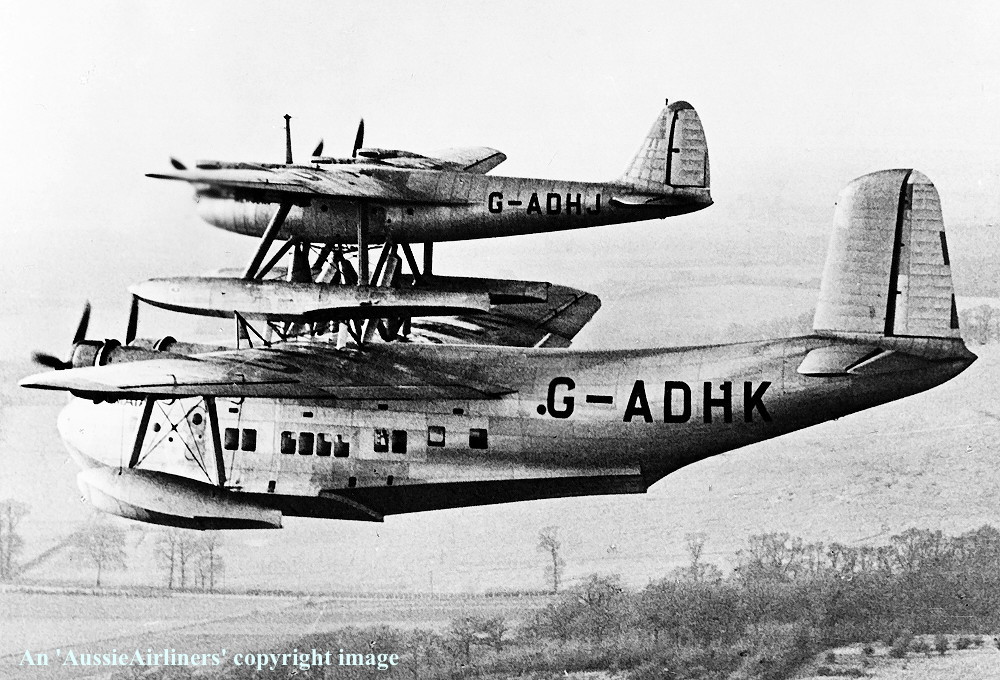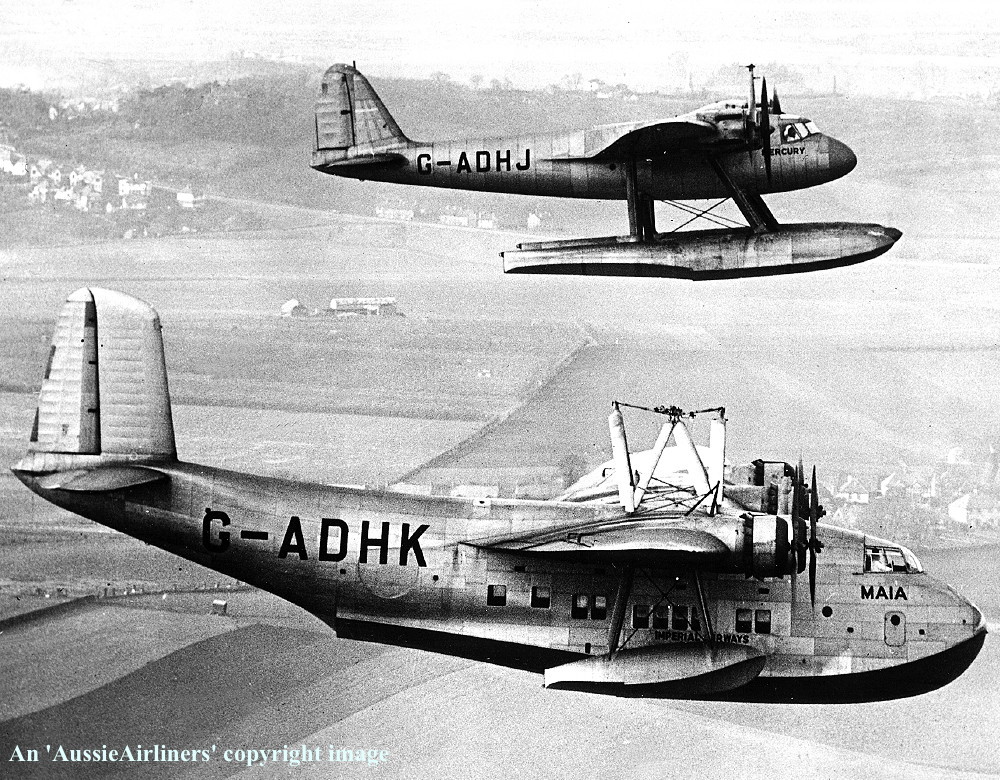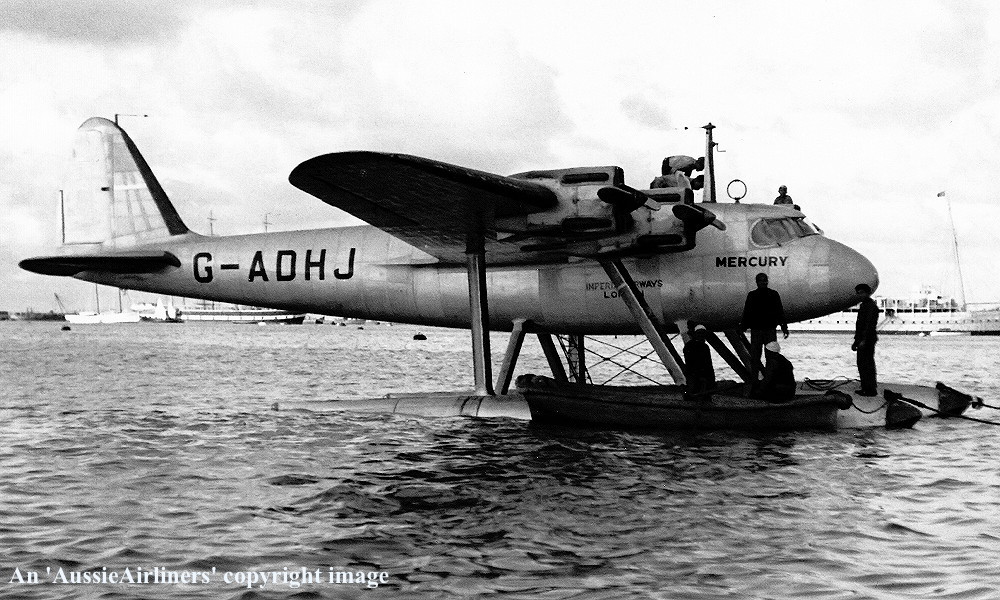G-ADHJ. Short S-22 Scion Senior Flying Boat. c/n S.796.
This float plane was built by Short Brothers (Rochester & Bedford) Ltd, Rochester It was built as an experimental long range mail aircraft to be operated across the Atlantic Ocean It was designed in conjunction with 'Maia' being the lower component of the combination It was designed by Arthur Gouge, Chief Designer, Short Bros and Robert H. Mayo, the Technical General Manager of Imperial Airways, London The contract based on the Specification 13/33 was placed with Short Brothers - 1935 Estimated cost of approximately UKL 600,000 was to be shared equally between the Treasury and Imperial Airways Built as an S-22 Scion Senior and modified to be a float plane It was powered by 365 hp Napier-Halford Rapier VI6 engines It had an empty weight of 10,163 lb (4,614 kg); an all-up solo weight of 15,500 lb (7,030 kg) It had an all-up weight for composite launching of 20,800 lb (9,443 kg) It had an all-up weight for the composite launch on the Cape Flight of 26,800 lb (12,160 kg) It had a maximum solo speed of 212 m.p.h. (339 km/hr) or 195 m.p.h. (314 km/hr) at maximum weight It had a range of 3,900 miles (6,240 km) when engaged in a normal composite launch It had a range of 6,100 miles (9,820 km) for the Cape Flight Entered onto the British Aircraft Register as G-ADHJ (CofR 5875) - June 17, 1935 Launched on the Medway River at Rochester - September 05, 1937 First flown from the Medway River (Captain John L. Parker) - September 05, 1937 This test flight lasted 15 minutes The second test flight of 40 minutes duration was flown as a handling test flight - September 06, 1937 The Certificate of Airworthiness (CofA 6342) Issued - September 06, 1937 The aircraft was named 'Mercury' It was displayed to the press at Rochester - September 08, 1937 The aircraft was mated with 'Maia' to form the 'Short Mayo Composite' - January 01, 1938 An initial taxying trial of 1 hour was undertaken - January 01, 1938 Captain John L. Parker was in 'Maia' and Captain Harold Piper was in 'Mercury' The second taxying trial of 45 minutes was completed - January 03, 1938 The Composite aircraft successfully rode out a gale at its moorings - January 1938 The third taxying trial of 40 minutes was completed - January 19, 1938 During the taxying trials Bill Hambrook stood atop 'Maia' to observe the release gear The first flight (20 minutes duration) of the combined 'Mayo Composite' took place - January 20, 1938 First successful 'Mayo Composite' separation near Rochester - February 06, 1938 Further test flying occured in the Felixstowe area of Suffolk ready for trans-Atlantic operations The first long-haul trial carried out - July 14, 1938 The 'Mercury' was launched from 'Maia' over Southampton and flew 2,040 miles to Foynes and out over the Atlantic Ocean and returned to Southampton for a flight duration of 12 hours During this flight 'Mercury' established radio contact with Foynes and Botwood (Newfoundland) First trans-Atlantic flight from Foynes (Ireland) - Boucherville (Montreal, Canada) - July 21, 1938 As well as the weight of 'Mercury' 'Maia' carried 10 passengers and luggage to Foynes after the successful separation Flight crew: Captain A. S. Wilcockson (Maia); Captain Don Bennett (Mercury) The distance from Foynes to Boucherville was 2,930 miles or 4,714 kms 'Mercury' was launched over Foynes at a gross weight of 20,800 lb including 600 lb of payload comprising of newspapers, press photographs and movie newsreels On separation 'Maia' would drop down whilst 'Mercury' would assume a climbing attitude 'Mercury' had a range of some 6,000 miles and the flight was completed it 20 hours 21 minutes This equated to an average ground speed of 144 m.p.h. (232 kts) On arrival at Monreal 'Mercury' had some 80 gallons of fuel remaining in the tanks This equated to just 54 gallons burnt per hour which was much lower than anticipated It was decided to attempt to set a new world record for a non-stop distance flight by seaplane - September 1938 The attempt would involve 'Mercury' flying from Dundee (Scotland) to Capetown (South Africa) Preparations for this flight were undertaken by Short Bros at Rochester The floats were strengthened and sealed to enable extra fuel to be carried 'Mercury' was launched from 'Maia' near Dundee - October 06, 1938 Severe headwinds and tropical thunderstorms slowed the flight The electric fuel pump in the floats failed and fuel had to be hand-pumped to the wing tanks 'Mercury' alighted on the Orange River near Alexander Bay having flown 6,045 miles in just over 42 hours Flight operations to Botwood were suspended due to ice condition until the summer months of 1939 'Mercury' was transferred to Felixstowe for use by RAF No. 320 Squadron This was a Dutch seaplane reconnaisance unit attached to the RAF based at Pembroke Dock 'Mercury' was registered to B.O.A.C. - August 27, 1940 This aircraft was returned to Short Brothers at Rochester - August 09, 1941 It was broken-up and its aluminium recycled for the war effort |
 |
G-ADHJ. Imperial Airways - 'Mercury' in the standard livery on the Medway River, Rochester, date unknown. (R. N. Smith Collection Copyright Image 2545-289.) |
 |
G-ADHJ & G-ADHK. Imperial Airways - 'Maia' & 'Mercury' in the standard livery on the Medway River, Rochester, January 1938. (R. N. Smith Collection Copyright Image 2545-290.) |
 |
G-ADHJ. & G-ADHK. Imperial Airways - 'Maia' & 'Mercury' in the standard livery on the Medway River, Rochester, January 1938. (R. N. Smith Collection Copyright Image 2545-817.) |
 |
G-ADHJ. & G-ADHK. Imperial Airways - 'Maia' & 'Mercury' in the standard livery somewhere near Rochester, February 06, 1938. (R. N. Smith Collection Copyright Image 2545-291.) |
 |
G-ADHJ. & G-ADHK. Imperial Airways - 'Maia' & 'Mercury' in the standard livery somewhere near Rochester, February 06, 1938. (R. N. Smith Collection Copyright Image 2545-292.) |
 |
G-ADHJ. Imperial Airways - 'Mercury' in the standard livery at Southampton, circa 1938. (R. N. Smith Collection Copyright Image 2545-818.) |